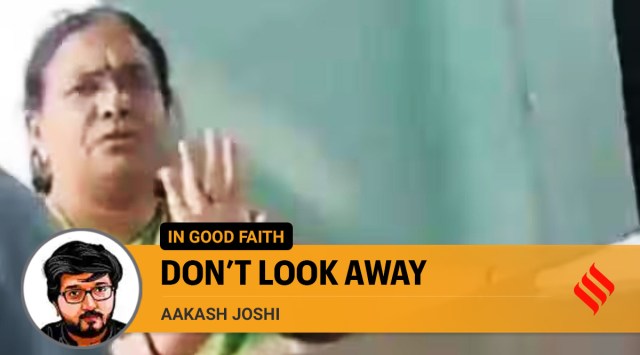
“Das Kabira Kahe Samjhai/Ant Kaal Tera Kaun Sahai/Sun Mere Sajan Sun Mere Meeta/Ya Jeevan Me Kya Kya Beeta.”
(How can Kabir explain to you my friend/At the end, who will be your helper?/ Listen, to me, lovers and friends/And bear witness to life).
— Kabir
“Bigotry,” an articulate friend said with force, “has become a spectator sport. And I will not be part of it.” She was, in a sense, correct.
The video in question is from a Muzaffarnagar school in which its principal, Tripta Tyagi, is seen turning children as young as seven years old into a mob. She instructs students to hit one of their classmates, while referring to his religion in a derogatory manner. He weeps and wails as his classmates – some, perhaps, friends — continue to hit him, humiliate him. It is a disturbing, chilling sight. It will stay with you, gnawing at your conscience. The images may come flashing back as you type out an email at work, or jostle around a crowded bus, train or metro. At least that’s what you think will happen.
The video hit social media on Friday. By Tuesday, we are back at work and mundane concerns like EMIs, holiday planning, family troubles and relationship woes, are once again front-of-mind. The boy’s cries return, at times. There is a pause when reports emerge that, according to his family, he cannot sleep after his public humiliation. But there is nothing you can do, is there? So, it’s time to move on. And, perhaps, it would have been better not to put yourself through that turmoil at all. To not feel, once again, a moral outrage that is, in a sense, impotent.
But the decision to look away, especially for those of us who are – by identity, faith, inheritance or privilege – members of the majority community, may not be the ethical one.
The clip from the small private school is rare, perhaps, in that it involves children. But it is part of a disturbing genre of videos that have become a part of our social media landscape. Even a cursory search for “Muslim man forced to chant Jai Shri Ram” throws up a vast number of hits. In many of these videos, it is the perpetrators themselves who have recorded their act. In a gross inversion of the global millennial’s lived motto – “if you didn’t (Insta)gram it, it didn’t happen” – they want, in these cases, to share their “exploit”.
So, does being constantly exposed to images of this kind of violence normalise it? Does watching them, as so many of us who often avoid viewing the acts of the mini lynch most believe, “desensitise” us?
There is a way of turning the “spectator sport” into something else. To do so, however, we require the moral courage not to be mere spectators but, in fact, bear witness.
The fatigue is understandable. The desire to look away, to sedate oneself with more pleasant content is all too human. And this is not completely our fault. As early as 2000, John Ellis argued in Seeing Things that violence and the way it is portrayed produces “a sense of complicity” among viewers when they watch it: The very act of viewing, in this scenario, feels like a tacit form of endorsement. This feeling may be particularly exacerbated in the digital age. Now, by watching, you are literally helping those that post videos make money and garner the currency of “views”.
There is, however, a difference between a viewer or spectator and a witness. In courts of law and even religious traditions, the idea of “bearing witness” carries with it a responsibility that is essential to an idea of community, of being a member of the public rather than just a body in a crowd, a passive consumer or a “pageview”. An act of witnessing is a commitment – both to memory and to those that suffer. It says that we will see and we will remember. And, if and when we can, we will act and help.
There is a reason we are told of Sita’s abduction, of Christ on the cross, of Hussain’s martyrdom and how Prophet Muhammad was abused. Those stories are not just of heroism, but also of villainy and depravity. There is also a reason – albeit a different one – that witnesses can be compelled to testify in a court of law. When we see, we assume at least some responsibility. When we look away, we preclude the possibility of empathy.
It is also important, not merely to view but to remember. In the Information Age, this is perhaps the most difficult of all. From Akhlaq to Junaid, Una to Muzzafarnagar – and from the highest pulpit in the capital to the village dealing with a civilisational system of hierarchy – there is a barrage of prejudice, of loud proclamations and convenient silences. To hold them all in our minds, to constantly see, remember and empathise requires a degree of fortitude. But, then, neither morality nor decency are easy.
And what of the impotence? Of the fact that we are, in large part, helpless? Perhaps at the current moment, there is nothing to be done. But even the possibility of action requires first that we look, and understand.
That may make us tremble, become sad, angry, and lose sleep. But as you lie awake in bed at night, remember, there might well be a seven-year-old boy, whose suffering is far greater than yours, that is doing the same. The least we can do is keep him in our minds.
aakash.joshi@expressindia.com